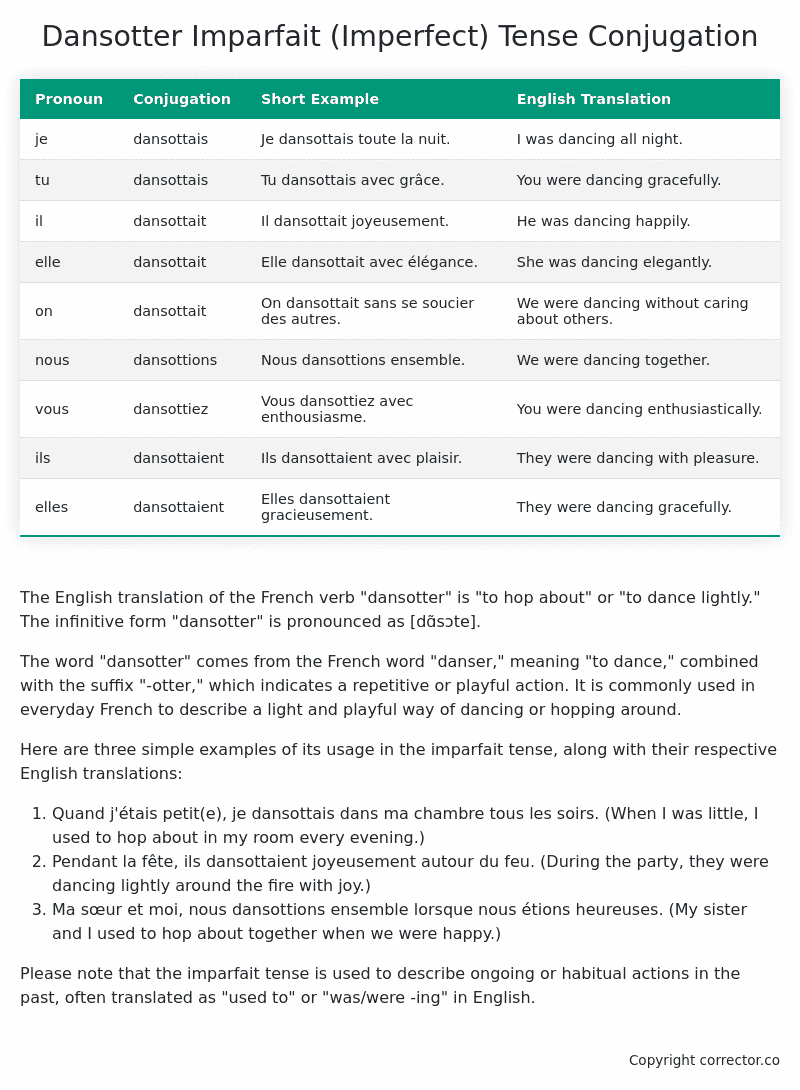Imparfait (Imperfect) Tense Conjugation of the French Verb dansotter
Introduction to the verb dansotter
The English translation of the French verb “dansotter” is “to hop about” or “to dance lightly.” The infinitive form “dansotter” is pronounced as [dɑ̃sɔte].
The word “dansotter” comes from the French word “danser,” meaning “to dance,” combined with the suffix “-otter,” which indicates a repetitive or playful action. It is commonly used in everyday French to describe a light and playful way of dancing or hopping around.
Here are three simple examples of its usage in the imparfait tense, along with their respective English translations:
- Quand j’étais petit(e), je dansottais dans ma chambre tous les soirs.
(When I was little, I used to hop about in my room every evening.) - Pendant la fête, ils dansottaient joyeusement autour du feu.
(During the party, they were dancing lightly around the fire with joy.) - Ma sœur et moi, nous dansottions ensemble lorsque nous étions heureuses.
(My sister and I used to hop about together when we were happy.)
Please note that the imparfait tense is used to describe ongoing or habitual actions in the past, often translated as “used to” or “was/were -ing” in English.
Table of the Imparfait (Imperfect) Tense Conjugation of dansotter
| Pronoun | Conjugation | Short Example | English Translation |
|---|---|---|---|
| je | dansottais | Je dansottais toute la nuit. | I was dancing all night. |
| tu | dansottais | Tu dansottais avec grâce. | You were dancing gracefully. |
| il | dansottait | Il dansottait joyeusement. | He was dancing happily. |
| elle | dansottait | Elle dansottait avec élégance. | She was dancing elegantly. |
| on | dansottait | On dansottait sans se soucier des autres. | We were dancing without caring about others. |
| nous | dansottions | Nous dansottions ensemble. | We were dancing together. |
| vous | dansottiez | Vous dansottiez avec enthousiasme. | You were dancing enthusiastically. |
| ils | dansottaient | Ils dansottaient avec plaisir. | They were dancing with pleasure. |
| elles | dansottaient | Elles dansottaient gracieusement. | They were dancing gracefully. |
Other Conjugations for Dansotter.
Le Present (Present Tense) Conjugation of the French Verb dansotter
Imparfait (Imperfect) Tense Conjugation of the French Verb dansotter (You’re reading it right now!)
Passé Simple (Simple Past) Tense Conjugation of the French Verb dansotter
Passé Composé (Present Perfect) Tense Conjugation of the French Verb dansotter
Futur Simple (Simple Future) Tense Conjugation of the French Verb dansotter
Futur Proche (Near Future) Tense Conjugation of the French Verb dansotter
Plus-que-parfait (Pluperfect) Tense Conjugation of the French Verb dansotter
Passé Antérieur (Past Anterior) Tense Conjugation of the French Verb dansotter
Futur Antérieur (Future Anterior) Tense Conjugation of the French Verb dansotter
Subjonctif Présent (Subjunctive Present) Tense Conjugation of the French Verb dansotter
Subjonctif Passé (Subjunctive Past) Tense Conjugation of the French Verb dansotter
Subjonctif Imparfait (Subjunctive Imperfect) Tense Conjugation of the French Verb dansotter
Subjonctif Plus-que-parfait (Subjunctive Pluperfect) Tense Conjugation of the French Verb dansotter
Conditionnel Présent (Conditional Present) Tense Conjugation of the French Verb dansotter
Conditionnel Passé (Conditional Past) Tense Conjugation of the French Verb dansotter
Conditionnel Passé II (Conditional Past II) Tense Conjugation of the French Verb dansotter
L’impératif Présent (Imperative Present) Tense Conjugation of the French Verb dansotter
L’impératif Passé (Imperative Past) Tense Conjugation of the French Verb dansotter
L’infinitif Présent (Infinitive Present) Tense Conjugation of the French Verb dansotter
L’infinitif Passé (Infinitive Past) Tense Conjugation of the French Verb dansotter
Le Participe Présent (Present Participle) Tense Conjugation of the French Verb dansotter
Le Participe Passé (Past Participle) Tense Conjugation of the French Verb dansotter
Struggling with French verbs or the language in general? Why not use our free French Grammar Checker – no registration required!
Get a FREE Download Study Sheet of this Conjugation 🔥
Simply right click the image below, click “save image” and get your free reference for the dansotter imparfait tense conjugation!

Dansotter – About the French Imparfait Tense
NOTE: To take a deep dive into all the French tenses then see our article on Mastering French Tense Conjugation.
Formation of the Imparfait Tense
For regular -er verbs:
For regular -ir verbs
For regular -re verbs
Common Everyday Usage Patterns
Description of Past Habits
Background Information
Mental and Emotional States
It’s employed to express emotions, thoughts, or physical sensations in the past. For example: “J’étais content quand il est arrivé.” (I was happy when he arrived.)
Ongoing Actions
Points to Note About the Imparfait Tense
Passé Composé vs. Imparfait
Conditional
Si Clauses
Narration
I hope you enjoyed this article on the verb dansotter. Still in a learning mood? Check out another TOTALLY random French verb imparfait conjugation!


